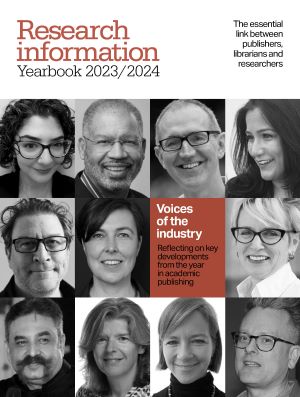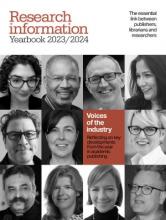Considering open access: talk from recent webinar
At the end of last year Research Information editor Siân Harris was guest on a Copyright Clearance Center webinar on open access. She reports on some of the things she discussed
The topic of open access (OA) has generated plenty of discussion over many years. Involvement in this webinar gave me an interesting opportunity to reflect on the topic and how it has evolved.
My perspective is that of an independent observer. Research Information, beyond being freely available itself, has no position on open access. In my own past experience, I have worked in research, library and publisher environments so I can see some of the concerns and frustrations from all the different people involved.
These concerns and frustrations have themselves shifted over time and it’s interesting to see this in looking back over articles we have published on the subject over the past decade. When OA issues were first talked about, the idea seemed to be very much about maintaining the original subscription route and enabling people to do some self-archiving and sharing.
Over the years, there seems to have been quite a dramatic shift in the conversations I’ve had with many publishers. They began to realise that the OA conversation isn’t going to go away and that perhaps there’s a risk to their businesses. That is when we started to see publishers doing more in the gold OA space, where there is money spent at the publication, instead of access, stage.
The webinar attendees, predominantly from the publishing side but also including librarians, researchers and others, were also asked about their thoughts on OA. A quick poll question asking for a prediction from the audience about which route would prevail 10 years from now yielded roughly the same number of votes for green as for gold. However, the majority expected it to continue to be not an either/or, but a yes/and situation. This didn’t surprise me. That’s what we hear quite a lot from the mixed picture of what funders, policy makers and others are saying.
It was also interesting to note that, in response to the poll question about which people preferred, the biggest proportion of the audience of the people listening to the call had no preference about whether OA is achieved with green or gold, with the second biggest proportion not responding to the question.
Sometimes conversations on social media about OA portray a large amount of polarisation and strong opinion about OA but I think this poll probably reflects more of the uncertainty of much of the population.
Roots of OA
OA is not a new idea and it originally arises from the desire to enable people to read the results of scientific research. It sounds like a no-brainer put like that but it’s not quite so simple. Who exactly these readers are seems to depends on the type of research. For example, there are very obvious and emotive reasons why members of the public might want to read about latest research into a medical condition they’ve just been diagnosed with. There are also some really trendy, popular research topics that have more general appeal - things like astronomy, for example.
However, without insulting anybody’s research area, there are plenty of topics that don’t really have any public appeal. In those cases, really the compelling reason for talking about access is for research access. There are particular issues for early-career researchers, researchers who are not affiliated to a research institution and people who are in a research institution or country that doesn’t have a lot of money. These kinds of issues have been exacerbated over the years with funding cuts and general price rises.
In November a new initiative, the Open Access Button was launched.This is a website where people log every time they get stumped by a pay wall. It’s an interesting picture. It’s still early days and there are many different factors – such as population sizes, numbers of researchers and adoption of the tool - but the early peak for encountering paywalls was in Europe, followed by the USA.
It is also important to mention that there are initiatives to enable access for people in the developing world (for example, Research4Life). Such initiatives are partly about providing access and partly about training people in how to use materials. It seems to me that it wouldn’t be a kind of good picture of the access discussion to not mention that actually a lot of the materials made available through these kind of programmes are from very big, highly profit-making corporate publishers. A similar situation happens with temporary access to medical workers in areas of the world hit by disasters.
It seems to me that it wouldn’t be a good picture of the access discussion to not mention that actually a lot of the materials made available through these kind of programmes are from very big, highly profit-making corporate publishers.
There’s another issue too that I’ve written about before and is close to my own experiences. This is the side issue of journalist access. There is an important role in many cases for specialist journalists and other science communicators to decode scientific research to enable it to be understood by members of the public. Crucially, this needs to be informed and accurate, which is obviously helped by those communicators having access to the original, published research.
Another force driving the push for open access has come from the people who are helping to pay for the research, the funders.
Types of OA
Green open access takes a number of different forms, whether it is putting versions of articles on an author’s own website or depositing them in an institutional or subject-specific repository. There have also been many discussions about which versions can be included – the author’s manuscript, corrected proofs or final published versions – and accompanying discussions about the risks of version confusion when people cite and use this information.
There are some ways to search across repositories but there is still a challenge for discoverability. Also, people use their repositories in multiple ways. An institutional repository collects research that has been published by people in institution, but it also acts as a sort of calling card for the institution with things that have been published within the institution as well.
This can make it harder for people to find really what they’re looking for. Initiatives like CHORUS, which has been proposed in the USA, could help answer the question of helping people to find their way round green repositories, helping people to know where things are and what versions people are looking at.
In the broadest terms, gold is where payment for the publication process happens on the author side rather than on the reader side. This might be through the author, institution or funder paying an article processing (or publication) charge or it might be some other form of sponsorship. However it is done, the publisher gets some money in order to support the publication and people read the material and do things with it for nothing. Exactly what people can do with it comes down to licences, which I’ll discuss a bit later.
In some discussions there seems to be a lack of information or awareness of what goes on behind the scenes in the publication process. It probably would not be a good service to researchers to simply stick a bit of research on a website and I think many people want to do more than that today.
Whenever I go to publishing conferences, I hear about the kind of processes that go on behind the scenes, such as the systems for submitting manuscripts and preserving content, as well as publishers’ involvement in industry initiatives like CrossRef, which does a range of things helping to ensure correct and permanent linking and ensuring that sources of funding attract and are attributed correctly to the papers they belong to. All of these things require significant efforts – and investment.
Geographical differences
There are some geographical differences in approaches to open access. The UK took a strong gold stance with the Finch report and the subsequent funder mandates. This interest in gold seems to be quite a common theme among sort of individual countries in Europe but the European Union has more of a green stance in making available the results of research that is funded centrally through the Horizon 2020 programme.
The USA is an interesting area to watch, having been the stage for many bills and counter-bills on the topic of access. In early 2013, the White House broadened its definition of which publically-funded research should be made available publically for free - with more of a green approach - beyond research funded by the NIH, the National Institutes of Health. Currently, there are two different approaches being proposed to try to facilitate this access, CHORUS from the publishing community and SHARE from the university community.
There are some other examples around the world. For example, there was an announcement recently from Argentina of an open-access mandate for the country and that had a strong focus on green and depositing in institutional repositories. This echoes an interest in green elsewhere in South America.
Industry projects
An interesting recent experiment to investigate green OA was the PEER project (Publishing and the Ecology of European Research). This was co-funded by the European Union and involved several major publishers and six international repositories. I think this was quite a revealing project and I’m surprised people don’t talk about it more.
Researchers were invited to submit their papers to this system and this, to me, seems an interesting way to gauge willingness of authors to engage in this type of process. The idea was that half of the papers into the system would be deposited by publishers and half would be deposited by researchers. The project team reported that 11,800 invitations were sent to researchers to submit their but only 170 papers were submitted by authors. The publishers were required to make up the shortfall in submissions in order to have enough papers in the system to be able to study things like access patterns.
However, the behaviour and usage elements of the PEER project suggested this was not a reflection of lack of interest in research papers being made available but more a feeling from researchers that they wanted publishers to be the ones doing this work; they didn’t see it as the authors’ job.
It will also be interesting to see what happens with SCOAP3, the initiative to make all high-energy physics journals gold OA. People involved in setting this up have told me that the process has been far from straightforward. Indeed one publisher ended up leaving the project.
OAPEN is another interesting project, looking at the effects of using the OA model with monographs.
Research differences
People talk a lot about whether there are different approaches to OA depending on whether researchers are scientists or social scientists, for example. I think possibly the most realistic thing is to say that all researchers are different; there’s no one type of research. I also think it’s a mistake to oversimplify the OA discussions as having publishers in one camp with one viewpoint and researchers as a homogenous block in another.
Certainly when the recommendations came out in the UK about publishing with a gold route, there was quite a backlash in petitions from researchers who really didn’t think this was a good idea, while others were strongly in favour of the moves.
I think there is still a kind of cloudiness in terms of awareness of the issues, aside from the researchers who spend a lot of time following OA. Many researchers ask me quite basic questions about OA and other publishing issues.
Librarian role
I was privileged recently to be invited to report on some roundtable discussions with librarians about OA, put together by SAGE, in partnership with the British Library (in 2012) and then in partnership with Jisc (in 2013).
These were very interesting because, although a publisher put the meetings together, the agenda were not set by the publisher. The librarians talked about the issues they faced. The 2013 roundtable took place three months after the OA mandates in the UK started and focused on UK librarians. Even in that short amount of time, they’d encountered many nitty-gritty problems with managing article processing charges. These included difficulties in paying publishers and making the payment attributed to the correct paper and dealing with researchers being split over more than one institution, country or funder.
I think this an issue that will remain a big challenge. It was interesting that despite the mandate in the UK being quite strongly in favour of the gold route, the librarian discussions revealed quite significant institutional preferences for a green route to OA.
Licensing and reuse
In the early days, people predominantly saw OA as an issue of putting things online to making them available. This gave rise to a range of ways to make content available and different things people could do with that content, which made a confusing picture.
In the last couple of years we’ve seen some significant efforts in trying to standardise things on the range of a Creative Commons licences (see More publishers move towards CC-BY licence for OA articles). There are some heated opinions on which are the best licences, but I think it’s a positive step to try to standardise approaches and communicate clearly what people can do with content. I think we will see more work in this area.
At this point of the webinar, an audience poll into which are the key issues in OA placed licensing top, followed by the impact of policy.
Text and data mining
Text and data mining is one of the most interesting issues for me. To some extent, the discussions about who pays what, when and how have been and will continue to go back and forth for quite a long time but text and data mining is a newer area for discussion. There is still so much uncertainty about standards, formats, what people want to do and really how to technically do text and data mining.
I was fortunate because in my research I did a large amount of X-ray crystallography, and this area has quite a long-standing tradition of submitting data with publications and being able to look at the body of data. I finished my PhD in 1998 and, even before then, whenever I characterised a new compound, I would look at the whole body of data and see how the bond lengths and angles in my latest compound compared with other similar things that have been published.
In a way, that gave me a taste of the kind of things that are possible and would be possible if a big body of research data is available in a standard way that is easy to handle and interrogate.
However, it is not easy, on either a technical and practical level or on a human-behavioural level. One aspect that is crucial in this is the sharing of data, something which researchers are often much more concerned and reluctant about than the sharing of published research results.
Looking to the future
If you’d ask me 10 years ago what the situation would be with OA, I might have predicted that everything would have been sorted out by now. This is clearly not the case – and there are many new issues that have come to the fore over the years, including the issue of open data that I touched on just now.
I predict some continuing practical challenges for everybody concerned. These will include issues for librarians and research institutions such as managing APC payments and the potential role of intermediaries to assist in this space.
There are also challenges around standardising the licensing of content under OA models, which still needs more work.
The issue of preservation is going to be an important one (see Preserving global scholarship). Under a subscription model there is an ongoing stream of money coming into a journal relating to old content. In contrast, paying to publish is a one-off payment and then the publisher receives no more money for that paper, which could be a challenge for some smaller or less-well capitalised publishers. And some OA models with a kind of membership setup involve the money being received even earlier, perhaps years before a paper is even submitted.
This could leave some publishers in the situation of running out of money to support and host content. I think that is unlikely to happen for a very big publisher, despite some moves to try to remove the publishers from the whole publication process. But I think there are some risks and some challenges for less well-financed publishers.
However, on the flipside, if papers are OA and have been released on very flexible licence terms, there’s nothing to stop people keeping copies of papers on their own computers or elsewhere on the internet. This means that even if a publisher goes out of business and has made no preservation plans, people can still access the paper, albeit in a less-organised form.
I think 10 years ago many publishers were quite entrenched in their particular positions but over the last decade they have been doing considerable experimentation and trying different options. Indeed, many major, traditional subscription publishers have bought or invested heavily in OA publishers, which muddies the water a little in terms of trying to make distinctions.
There are some very interesting things ahead. Probably if you asked everybody who’s listened to this call to predict what those are, you’d probably get as many answers as there are people on this call.






